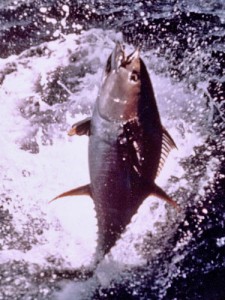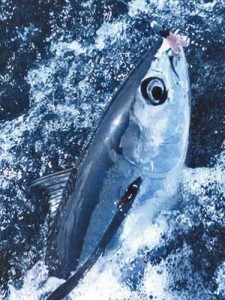Several species of tuna are fished commercially off the coasts of North America including Atlantic bluefin, Pacific bluefin, bigeye, yellowfin, albacore, and skipjack tuna.
Bigeye Tuna
The bigeye tuna is one of the largest tuna species. In North America, bigeye are landed from Canada to Florida using rod and reel or longline gear. The meat of bigeye has a mild flavor and high fat content, making it popular for sashimi.
Bluefin Tuna (Western Atlantic)
The bluefin is the largest of North America’s tuna, reaching weights of nearly a ton. Bluefin tuna are caught commercially using rod-and-reel, handline, harpoon, and purse seines.

Yellowfin Tuna
The yellowfin tuna (Thunnus albacares) is found in open waters of tropical and subtropical seas worldwide.
Yellowfin tuna reach lengths of more than 8 feet and can weigh over 400 lbs. Adults are dark metallic blue above with a pattern of vertical lines along the sides and silver on the belly.
Yellowfin get their name from the coloration of the second dorsal fin and the anal fin which are usually bright yellow.
The dorsal and anal fins can be very long in mature fish. Fish displaying this feature are known as “allison tuna” by fishermen. Yellowfin tuna are also known as ahi in Hawaii.
Yellowfin tuna are caught commercially in using longline gear, purse seine, rod and reel, green stick rigs, and hand lines.
The majority of U.S. commercial fishing effort is by longliners operating in the northwest Atlantic, Gulf of Mexico, and the Caribbean.

Albacore Tuna
Longfin albacore tuna can reach as much as 100 lbs although the average market weight is 20 lbs. Albacore tuna are distinguished by a dark blue back, and silver white sides and belly. Adult albacore tuna have pectoral fins that extend past the second dorsal fin and anal fin.
The flesh of albacore is pink when raw. Cooked albacore tuna is white in color with a mild taste and soft texture. Albacore is the only species allowed to be labeled as “white meat” tuna.
Canada’s Pacific albacore tuna fishery includes vessels that fish the coastal waters of British Columbia and the west coast of the United States, as well as a high seas fleet of larger vessels operating in international waters. A smaller albacore fishery exists in the Maritime provinces.
U.S. West Coast commercial fishermen catch albacore using troll and pole-and-line gear. In Hawaii, fishermen land albacore with longline gear for local fresh fish markets. Atlantic fishermen catch relatively small numbers of albacore, using longline gear and rod and reel.
Skipjack Tuna
The skipjack is a small but highly migratory tuna which is found along both the Atlantic and Pacific coasts of North America, as well as other areas worldwide. Skipjacks often form mixed schools with small yellowfin tuna.
The meat of the skipjack has a somewhat darker of color sometimes even slightly pinkish. It has a relatively tender texture, and is has somewhat more a fishy taste then some other tuna species. The small size of skipjack is well suited for canned tuna.
In the Atlantic, U.S. commercial fishermen mainly use handgear to harvest skipjack tuna. In the Pacific, skipjacks are landed with purse seines, pelagic longlines, and other gear.
Tuna Management
North American tuna stocks are managed internationally by regional fisheries management organizations, including the Western and Central Pacific Fisheries Commission (WCPFC), Inter-American Tropical Tuna Commission (IATTC), and International Commission for the Conservation of Atlantic Tunas (ICCAT.
NOAA Fisheries, the Atlantic Highly Migratory Species Division, and regional fishing councils oversee tuna fisheries in the United States, based upon IATTC and WCPFC conservation and management measures.
Related Information